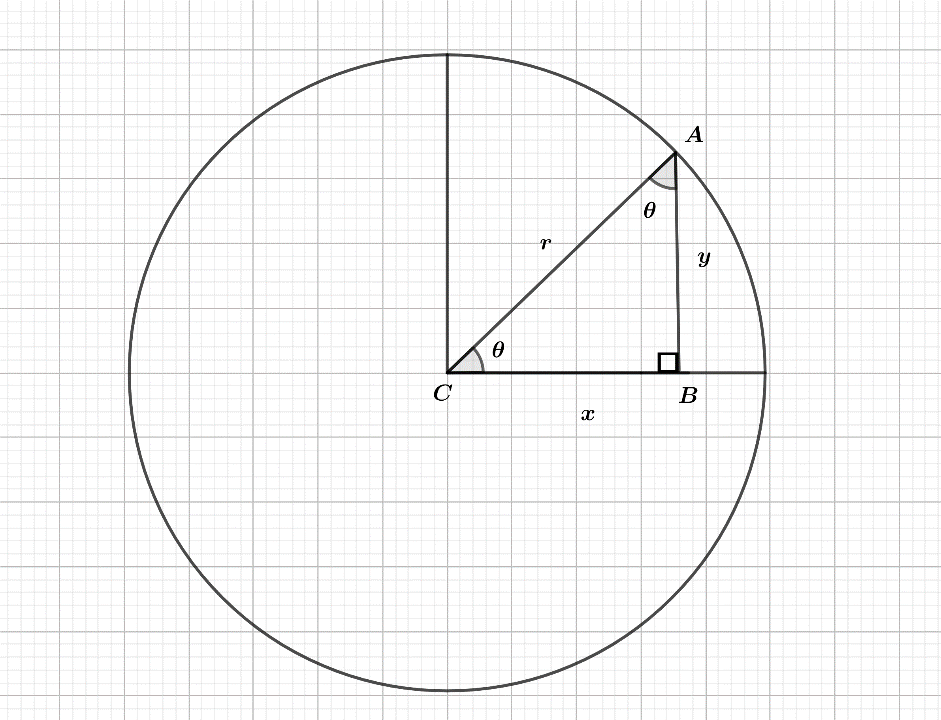
How do you convert $ r=4\cos \left( \theta \right) $ into rectangular form?
Answer
546.6k+ views
Hint: here, we are asked to convert the equation given in polar coordinates $ \left( r,\theta \right) $ into an equation in rectangular coordinates (x,y). Basically, we need to convert polar coordinates into rectangular coordinates. Completing the square method and Pythagoras theorem is also used in this question.
Use the following formulae for the conversion:
$ \begin{align}
& \Rightarrow x=r\cos \theta \\
& \Rightarrow y=r\sin \theta \\
& \Rightarrow \sqrt{{{x}^{2}}+{{y}^{2}}}=r \\
& \Rightarrow \theta ={{\tan }^{-1}}\left( \dfrac{y}{x} \right) \\
\end{align} $
According to Pythagoras theorem:
$ {{\left( hypotenuse \right)}^{2}}={{\left( perpendicular \right)}^{2}}+{{\left( base \right)}^{2}} $
Complete step by step answer:
Now, let’s solve the question.

From figure, we can say that the angle formed on the x-axis will be $ r\cos \theta $ and similarly, angle form on the y-axis will be $ r\sin \theta $ . So we can say that:
$ \begin{align}
& \Rightarrow x=r\cos \theta \\
& \Rightarrow y=r\sin \theta \\
\end{align} $
And by using Pythagoras theorem:
$ \begin{align}
& \Rightarrow {{x}^{2}}+{{y}^{2}}={{r}^{2}} \\
& \Rightarrow \sqrt{{{x}^{2}}+{{y}^{2}}}=r \\
\end{align} $
The measure of angle $ \theta $ will be: $ \theta ={{\tan }^{-1}}\left( \dfrac{y}{x} \right) $ .
Our given equation is:
$ \Rightarrow r=4\cos \left( \theta \right) $
Now, multiply both sides with ‘r’. we get:
$ \begin{align}
& \Rightarrow r\times r=r\times 4\cos \left( \theta \right) \\
& \Rightarrow r\times r=4r\cos \left( \theta \right) \\
\end{align} $
As we know $ x=r\cos \theta $ . Now substitute the value of x in above equation. We get:
$ \Rightarrow {{r}^{2}}=4\times x $
And we also know that $ \Rightarrow {{x}^{2}}+{{y}^{2}}={{r}^{2}} $ . Now substitute this also in above equation. We get:
$ \Rightarrow {{x}^{2}}+{{y}^{2}}=4x $
On further solving:
$ \begin{align}
& \Rightarrow {{x}^{2}}+{{y}^{2}}-4x=0 \\
& \Rightarrow {{x}^{2}}-4x+{{y}^{2}}=0 \\
\end{align} $
Now by completing the square method, add 4 on both the sides of the equation formed above. We get:
$ \Rightarrow {{x}^{2}}-4x+4+{{y}^{2}}=0+4 $
Now we can see that $ {{x}^{2}}-4x+4 $ can be factorised as $ {{\left( x-2 \right)}^{2}} $ . So place the factors in the equation. We get:
$ \Rightarrow {{\left( x-2 \right)}^{2}}+{{y}^{2}}=4 $
So, $ r=4\cos \left( \theta \right) $ in rectangular form is $ {{\left( x-2 \right)}^{2}}+{{y}^{2}}=4 $ .
Note:
The main point that should keep in mind is that you need to factorize in the end. You can also see that in the end, the radius in the answer is $ \sqrt{4}=2 $ . ‘r’ needs to be multiplied in the first step, because without it you cannot proceed further.
Use the following formulae for the conversion:
$ \begin{align}
& \Rightarrow x=r\cos \theta \\
& \Rightarrow y=r\sin \theta \\
& \Rightarrow \sqrt{{{x}^{2}}+{{y}^{2}}}=r \\
& \Rightarrow \theta ={{\tan }^{-1}}\left( \dfrac{y}{x} \right) \\
\end{align} $
According to Pythagoras theorem:
$ {{\left( hypotenuse \right)}^{2}}={{\left( perpendicular \right)}^{2}}+{{\left( base \right)}^{2}} $
Complete step by step answer:
Now, let’s solve the question.

From figure, we can say that the angle formed on the x-axis will be $ r\cos \theta $ and similarly, angle form on the y-axis will be $ r\sin \theta $ . So we can say that:
$ \begin{align}
& \Rightarrow x=r\cos \theta \\
& \Rightarrow y=r\sin \theta \\
\end{align} $
And by using Pythagoras theorem:
$ \begin{align}
& \Rightarrow {{x}^{2}}+{{y}^{2}}={{r}^{2}} \\
& \Rightarrow \sqrt{{{x}^{2}}+{{y}^{2}}}=r \\
\end{align} $
The measure of angle $ \theta $ will be: $ \theta ={{\tan }^{-1}}\left( \dfrac{y}{x} \right) $ .
Our given equation is:
$ \Rightarrow r=4\cos \left( \theta \right) $
Now, multiply both sides with ‘r’. we get:
$ \begin{align}
& \Rightarrow r\times r=r\times 4\cos \left( \theta \right) \\
& \Rightarrow r\times r=4r\cos \left( \theta \right) \\
\end{align} $
As we know $ x=r\cos \theta $ . Now substitute the value of x in above equation. We get:
$ \Rightarrow {{r}^{2}}=4\times x $
And we also know that $ \Rightarrow {{x}^{2}}+{{y}^{2}}={{r}^{2}} $ . Now substitute this also in above equation. We get:
$ \Rightarrow {{x}^{2}}+{{y}^{2}}=4x $
On further solving:
$ \begin{align}
& \Rightarrow {{x}^{2}}+{{y}^{2}}-4x=0 \\
& \Rightarrow {{x}^{2}}-4x+{{y}^{2}}=0 \\
\end{align} $
Now by completing the square method, add 4 on both the sides of the equation formed above. We get:
$ \Rightarrow {{x}^{2}}-4x+4+{{y}^{2}}=0+4 $
Now we can see that $ {{x}^{2}}-4x+4 $ can be factorised as $ {{\left( x-2 \right)}^{2}} $ . So place the factors in the equation. We get:
$ \Rightarrow {{\left( x-2 \right)}^{2}}+{{y}^{2}}=4 $
So, $ r=4\cos \left( \theta \right) $ in rectangular form is $ {{\left( x-2 \right)}^{2}}+{{y}^{2}}=4 $ .
Note:
The main point that should keep in mind is that you need to factorize in the end. You can also see that in the end, the radius in the answer is $ \sqrt{4}=2 $ . ‘r’ needs to be multiplied in the first step, because without it you cannot proceed further.
Recently Updated Pages
Master Class 12 Business Studies: Engaging Questions & Answers for Success

Master Class 12 Economics: Engaging Questions & Answers for Success

Master Class 12 English: Engaging Questions & Answers for Success

Master Class 12 Maths: Engaging Questions & Answers for Success

Master Class 12 Social Science: Engaging Questions & Answers for Success

Master Class 12 Chemistry: Engaging Questions & Answers for Success

Trending doubts
Who was the first woman to receive Bharat Ratna?

Write a letter to the principal requesting him to grant class 10 english CBSE

Why is there a time difference of about 5 hours between class 10 social science CBSE

What is the median of the first 10 natural numbers class 10 maths CBSE

The Equation xxx + 2 is Satisfied when x is Equal to Class 10 Maths

Discuss the main reasons for poverty in India




